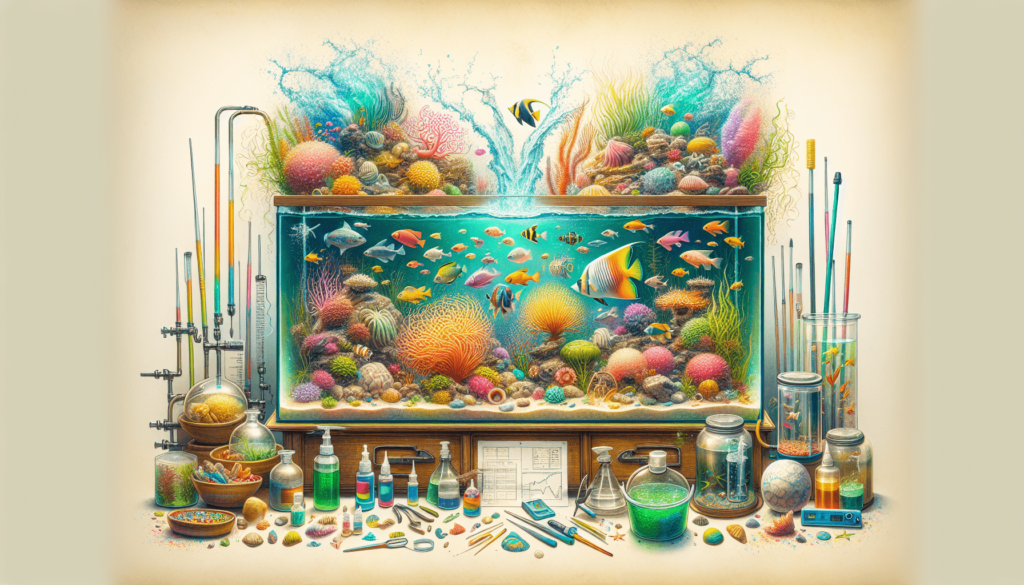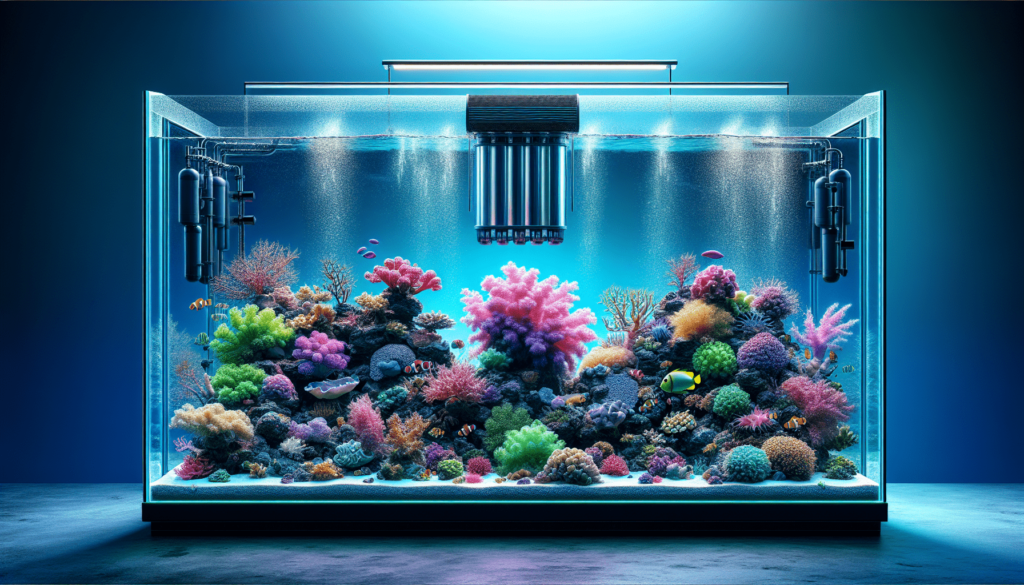So you’re thinking about getting into the world of aquariums and wondering if saltwater tanks are suitable for beginners. Well, the answer is not as simple as a yes or no. While saltwater tanks can be a bit more challenging to maintain compared to freshwater tanks, they can also be incredibly rewarding. From the vibrant colors of different fish species to the mesmerizing corals and rock formations, saltwater tanks offer a stunning underwater world to explore. However, they do require a bit more knowledge, patience, and investment to set up and maintain. In this article, we will explore the pros and cons of saltwater tanks for beginners, giving you a clearer picture of whether this aquatic adventure is the right fit for you.
What is a saltwater tank?
A saltwater tank, also known as a marine aquarium, is a specially designed aquarium that houses marine fish, invertebrates, and coral. Unlike freshwater tanks, which house fish and plants that thrive in freshwater environments, saltwater tanks recreate the conditions found in the ocean, including the salinity of the water and the specific needs of marine life.
Definition of a saltwater tank
A saltwater tank is a controlled aquatic environment that mimics the conditions of the ocean, providing a suitable habitat for marine fish, invertebrates, and coral. It requires the careful balance of water chemistry, appropriate equipment, and regular maintenance to ensure the health and well-being of the tank’s inhabitants.
Difference between saltwater tanks and freshwater tanks
The main difference between saltwater tanks and freshwater tanks lies in the salinity of the water and the specific needs of the aquatic life they house. Saltwater tanks require marine-grade salt mix to achieve the proper salinity level, while freshwater tanks use tap water treated with a dechlorinator. Additionally, saltwater tanks often require more complex filtration systems and lighting setups to support the growth of coral and maintain water quality.
Considerations for beginners
Before embarking on the journey of owning a saltwater tank, there are several important considerations for beginners to keep in mind.
Level of experience
One of the first things to consider is your level of experience with aquariums. If you are a beginner with little to no experience in fishkeeping, starting with a saltwater tank may not be the best choice. Saltwater tanks require a greater level of expertise and attention to detail compared to freshwater tanks.
Time commitment
Owning a saltwater tank also requires a significant time commitment. Regular maintenance, including water testing, cleaning, and feeding, is necessary to ensure the well-being of the tank’s inhabitants. Beginners should be prepared to dedicate the time needed to properly care for their saltwater tank.
Budget
Another consideration for beginners is the budget required to set up and maintain a saltwater tank. Saltwater tanks often come with a higher cost compared to freshwater tanks due to the specialized equipment and marine-grade supplies needed. It is important to factor in expenses such as the tank itself, filtration systems, lighting, live rock, marine salt mix, and livestock when budgeting for a saltwater tank.

Benefits of saltwater tanks for beginners
While saltwater tanks may present challenges for beginners, there are several benefits that make them an attractive option for those interested in the marine aquarium hobby.
Variety of marine life
One of the most enticing aspects of saltwater tanks is the incredible variety of marine life that can be housed. From colorful tropical fish to vibrant coral species, saltwater tanks offer a diverse and visually stunning array of options for beginners to explore.
Beautiful aesthetics
Saltwater tanks are known for their stunning aesthetics. The vibrant colors of coral, the graceful movements of fish, and the intricate rock formations create a visually captivating underwater world. For beginners with a passion for beauty and aesthetics, a saltwater tank can be a wonderful addition to their living space.
Educational opportunities
Owning a saltwater tank provides ample educational opportunities for beginners. The intricate balance of water chemistry, the understanding of different species’ behavioral patterns, and the observation of marine life’s unique reproductive processes all contribute to a valuable learning experience. Saltwater tanks can foster a deeper understanding and appreciation for the wonders of the underwater world.
Challenges of saltwater tanks for beginners
While saltwater tanks offer numerous benefits, beginners should also be aware of the challenges that come with owning one.
Water chemistry
Maintaining proper water chemistry is crucial in a saltwater tank. The delicate balance of pH, salinity, and nutrient levels requires frequent monitoring and adjustments. Beginners may find it challenging to grasp the concepts of water chemistry and may need to invest time in learning and understanding the intricacies of saltwater tank maintenance.
Equipment complexity
Saltwater tanks often require more complex equipment compared to freshwater tanks. Advanced filtration systems, protein skimmers, and precise lighting setups are necessary to replicate the conditions of the ocean. Beginners may find the learning curve for understanding and operating these complex systems to be steep, requiring patience and research.
Maintenance requirements
Saltwater tanks have higher maintenance requirements compared to freshwater tanks. Regular water testing, performing water changes, and monitoring water parameters are all essential tasks to ensure the health and well-being of the tank’s inhabitants. Beginners should be prepared to commit time and effort to these regular maintenance tasks to keep their saltwater tank thriving.

Beginner-friendly saltwater tank options
For beginners looking to venture into the world of saltwater tanks, there are several beginner-friendly options to consider.
Nano reef tanks
Nano reef tanks are small-sized saltwater tanks that typically range from 10 to 30 gallons in capacity. These compact setups offer a manageable starting point for beginners, requiring less space and potentially lower costs compared to larger tanks. Nano reef tanks can still house a variety of marine life, including small fish and coral, while offering the opportunity to learn and practice proper saltwater tank maintenance.
All-in-one systems
All-in-one systems are saltwater tanks that come with a built-in filtration system, heating, and lighting. These fully equipped setups provide beginners with an easy-to-manage option, as they eliminate the need to source and purchase separate equipment. All-in-one systems often include comprehensive instructions and guides, making it simpler for beginners to set up and maintain their saltwater tank.
Coral-only tanks
For beginners primarily interested in coral and not fish, a coral-only tank can be an ideal choice. These specialized tanks focus on creating the perfect environment for coral growth, emphasizing lighting and water flow. Coral-only tanks are often easier to maintain compared to tanks with fish, as they require fewer water parameter adjustments and less feeding. However, beginners should still be prepared to learn and understand the specific needs of coral to ensure their success.
Essential equipment for beginners
To set up a successful saltwater tank, beginners should invest in the following essential equipment:
Proper filtration system
A reliable and effective filtration system is essential for maintaining water quality in a saltwater tank. It helps remove harmful substances, such as excess nutrients and waste, while providing a stable and healthy environment for the tank’s inhabitants. Beginners should research and invest in a filtration system suitable for the size of their tank and the specific needs of the marine life they plan to keep.
Quality lighting
Quality lighting is crucial for the health and growth of coral in a saltwater tank. Different species of coral require specific lighting intensities and spectrums to thrive. Beginners should choose lighting fixtures designed for saltwater tanks and consider the lighting requirements of the coral they intend to keep.
Heater and thermometer
Maintaining a stable water temperature is vital for the well-being of marine life in a saltwater tank. A reliable heater and thermometer are essential to regulate and monitor the water temperature accurately. Beginners should choose a heater that is suitable for the size of their tank and invest in a quality thermometer to ensure consistent and appropriate water temperatures.
Reef-safe salt mix
To achieve the proper salinity level in a saltwater tank, beginners need to mix marine salt with water. It is crucial to choose a high-quality, reef-safe salt mix to avoid introducing harmful substances into the tank. Beginners should research and select a salt mix brand trusted by experienced hobbyists to ensure the health and well-being of their marine life.
Basic steps to set up a saltwater tank
Setting up a saltwater tank requires careful planning and execution. Beginners should follow these basic steps to establish a healthy and thriving saltwater ecosystem:
Tank selection and placement
Choose an appropriate tank size based on available space and the desired marine life. Place the tank on a sturdy and level surface away from direct sunlight and extreme temperature fluctuations. Ensure the tank is easily accessible for maintenance and monitoring.
Installing equipment
Install the necessary equipment, including the filtration system, heater, lighting fixtures, and protein skimmer, following manufacturer instructions. Ensure proper placement and connections to create an optimal environment for the tank’s inhabitants.
Cycling the tank
Cycling the tank refers to the process of establishing beneficial bacteria colonies that break down ammonia and nitrite, which are harmful to marine life. Beginners can start the cycling process by adding a source of ammonia to the tank, such as pure ammonia or a small piece of raw shrimp. Regular water testing will indicate when the tank has completed the cycling process and is ready for livestock.
Adding live rock and sand
Live rock and sand provide a natural habitat and filtration system for a saltwater tank. Carefully arrange live rock to create caves and hiding spots for fish and invertebrates. Rinse and add live sand to the bottom of the tank, ensuring a layer thick enough to support healthy biological processes.
Monitoring water parameters
Regularly test the water parameters, including salinity, pH, ammonia, nitrite, and nitrate levels, to ensure they are within optimal ranges for the tank’s inhabitants. Adjust water chemistry as needed, following best practices and recommendations from experts in the field.
Choosing compatible marine life
Selecting the right marine life for a saltwater tank is crucial to maintaining a harmonious and thriving ecosystem. Beginners should consider the following factors when choosing compatible species:
Researching fish and invertebrate species
Thoroughly research different fish and invertebrate species to understand their needs, behaviors, and compatibility with other species. Consider factors such as size, temperament, and tank requirements to ensure the chosen marine life will coexist peacefully.
Considering tank size and behavior
The tank size plays a significant role in determining suitable marine life. Larger fish or species with aggressive tendencies may require a larger tank to provide sufficient space for movement and territory. Consider the behavior and compatibility of species to prevent aggression or stress among tank inhabitants.
Introducing livestock gradually
To minimize stress and adaptability issues, gradually introduce livestock into the tank. Start with a few hardy and compatible species, allowing them to acclimate to the tank environment before adding more delicate or sensitive species. Ensure proper quarantine procedures to prevent the introduction of diseases or parasites into the tank.
Maintenance tips for beginners
Proper maintenance is essential for the long-term success of a saltwater tank. Beginners should follow these tips to keep their tank healthy and thriving:
Regular water testing
Regularly test water parameters, such as salinity, pH, ammonia, nitrite, and nitrate levels, using reliable test kits. Monitoring these parameters will help identify potential issues early on and allow for prompt corrective actions. Maintain accurate records of test results to track any trends or changes in water quality.
Performing water changes
Regular water changes are crucial for maintaining water quality and removing accumulated debris and waste. Beginners should aim to perform regular partial water changes, replacing a portion of the aquarium water with fresh, properly mixed saltwater. The frequency and volume of water changes may vary depending on the tank’s size, the number of inhabitants, and the specific needs of the marine life.
Practicing proper feeding
Feed fish and invertebrates a balanced and appropriate diet suitable for their species. Overfeeding can lead to water quality issues, while underfeeding can negatively impact the health and vitality of marine life. Beginners should research the dietary needs of their specific marine species and feed them accordingly, ensuring any uneaten food is promptly removed from the tank.
Cleaning and maintaining equipment
Regularly clean and maintain equipment, including filters, protein skimmers, and lighting fixtures, following manufacturer instructions. Cleaning equipment ensures optimal performance and efficiency, reducing the risk of equipment failure or compromised water quality. Stick to a regular maintenance schedule to prevent the buildup of debris or harmful substances.
Conclusion
Saltwater tanks offer a captivating and rewarding experience for beginners who are willing to invest time, effort, and research into their maintenance. While they present challenges, such as water chemistry management and equipment complexity, with proper preparation and education, saltwater tanks can be suitable for beginners. The diverse range of marine life, beautiful aesthetics, and educational opportunities make saltwater tanks an appealing choice for those looking to explore the wonders of the underwater world. By following the provided guidelines and focusing on proper research and preparation, beginners can successfully set up and maintain a thriving saltwater tank.

My name is James Gheen, and I am thrilled to welcome you to Tropical Fish Farmers, the ultimate destination for everything related to tropical fish breeding. As an avid underwater enthusiast, I am dedicated to sharing my knowledge and experience to help you successfully breed and care for tropical fish. Whether you’re a beginner starting your aquarium journey or a seasoned breeder looking to expand your knowledge, my website has something for everyone. Dive into our extensive library of articles, tutorials, and videos covering various topics to enhance your breeding success. Join me in our vibrant community and let’s contribute to responsible fish breeding and conservation efforts together. Discover Tropical Fish Farmers and become part of our global community today.

